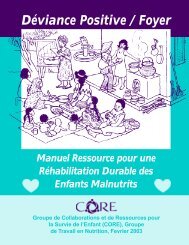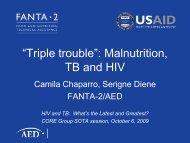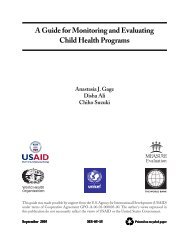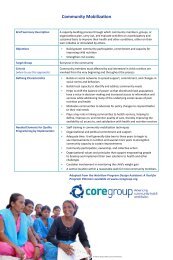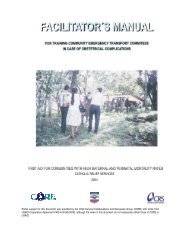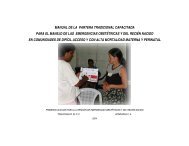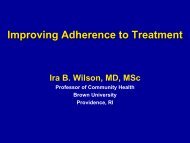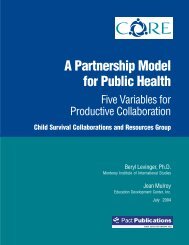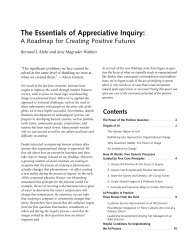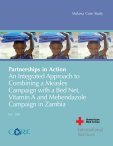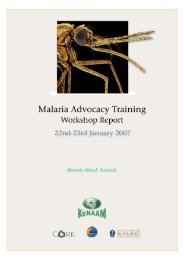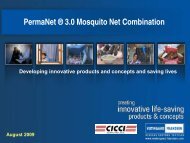Community Approaches to Child Health in Malawi: - CORE Group
Community Approaches to Child Health in Malawi: - CORE Group
Community Approaches to Child Health in Malawi: - CORE Group
Create successful ePaper yourself
Turn your PDF publications into a flip-book with our unique Google optimized e-Paper software.
<strong>Community</strong> <strong>Approaches</strong> <strong>to</strong><br />
<strong>Child</strong> <strong>Health</strong> <strong>in</strong> <strong>Malawi</strong>:<br />
Apply<strong>in</strong>g the <strong>Community</strong> Integrated<br />
Management of <strong>Child</strong>hood Illness<br />
(C-IMCI) Framework<br />
April 2009
This document was made possible by support from the <strong>Child</strong> Survival and<br />
<strong>Health</strong> Grants Program with<strong>in</strong> the Bureau of Global <strong>Health</strong>, U.S. Agency<br />
for International Development (USAID) under cooperative agreement GHS-<br />
A-00-05-00006-00. This publication does not necessarily represent the view or<br />
op<strong>in</strong>ion of USAID. It may be reproduced if credit is properly given.
Abstract<br />
The C-IMCI Framework, created <strong>in</strong> January 2001 based on<br />
nongovernmental organization (NGO) child health program experiences,<br />
presents a guide for programm<strong>in</strong>g community-based efforts that <strong>in</strong>volve<br />
all of the <strong>in</strong>stitutions and people who play a critical role <strong>in</strong> improv<strong>in</strong>g child<br />
health.<br />
The C-IMCI Framework is made up of three elements: (1) improv<strong>in</strong>g<br />
partnerships between health facilities and the communities they serve;<br />
(2) <strong>in</strong>creas<strong>in</strong>g appropriate and accessible health care and <strong>in</strong>formation<br />
from community-based providers; and (3) <strong>in</strong>tegrat<strong>in</strong>g promotion of key<br />
family practices critical for child health and nutrition, and a multi-sec<strong>to</strong>ral<br />
platform. The <strong>in</strong>tent of the C-IMCI Framework is <strong>to</strong> enable NGOs and<br />
governments <strong>to</strong> categorize their exist<strong>in</strong>g community-based program efforts<br />
and develop and implement a coord<strong>in</strong>ated, <strong>in</strong>tegrated strategy <strong>to</strong> improve<br />
child health. The framework is designed <strong>to</strong> address each of the three key<br />
elements and a multi-sec<strong>to</strong>ral platform that would be most effective <strong>in</strong><br />
improv<strong>in</strong>g child health.<br />
Now that multiple NGOs have been implement<strong>in</strong>g C-IMCI for several<br />
years, the <strong>CORE</strong> <strong>Group</strong> seeks <strong>to</strong> document NGO country programs that<br />
have used the framework <strong>to</strong>: 1) improve health outcomes; 2) positively<br />
<strong>in</strong>fluence health policy; and/or 3) expand coord<strong>in</strong>ated delivery of health<br />
<strong>in</strong>terventions at a district or regional level.<br />
This paper documents World Relief’s approach <strong>to</strong> C-IMCI <strong>in</strong>terventions<br />
at the household level <strong>in</strong> <strong>Malawi</strong>, where the government is dedicated<br />
<strong>to</strong> implement<strong>in</strong>g C-IMCI through its community network of health<br />
surveillance assistants.<br />
Recommended Citation<br />
<strong>CORE</strong> <strong>Group</strong>, April 2009. <strong>Community</strong> <strong>Approaches</strong> <strong>to</strong> <strong>Child</strong> <strong>Health</strong> <strong>in</strong><br />
<strong>Malawi</strong>—Apply<strong>in</strong>g the C-IMCI Framework.<br />
Acknowledgements<br />
Special thanks <strong>to</strong> Vic<strong>to</strong>r Kabaghe, World Relief Field Program Direc<strong>to</strong>r <strong>in</strong><br />
<strong>Malawi</strong>; Melanie Morrow, World Relief Direc<strong>to</strong>r of Maternal and <strong>Child</strong><br />
<strong>Health</strong> Programs; and Olga Woll<strong>in</strong>ka, consultant <strong>to</strong> World Relief. Thanks<br />
also <strong>to</strong> Dr. Henry Perry, Drs. Warren and Gretchen Berggren, W. Meredith<br />
Long, Lynette Walker, Karen LeBan, Nazo Kureshy, Erika Lutz, and Julia<br />
Ross for review and edit<strong>in</strong>g several drafts. Additionally, Dr. Carl Taylor, and<br />
Paul Makandawire provided helpful comments on early drafts.<br />
i<br />
<strong>Community</strong> <strong>Approaches</strong> <strong>to</strong> <strong>Child</strong> <strong>Health</strong> <strong>in</strong> <strong>Malawi</strong>
<strong>CORE</strong> <strong>Group</strong><br />
<strong>CORE</strong> <strong>Group</strong> fosters collaborative action and learn<strong>in</strong>g <strong>to</strong> advance the<br />
effectiveness and scale of community-focused public health practices.<br />
Established <strong>in</strong> 1997, <strong>CORE</strong> <strong>Group</strong> is a 501(c) 3 membership association<br />
based <strong>in</strong> Wash<strong>in</strong>g<strong>to</strong>n, DC that is comprised of citizen-supported NGOs<br />
work<strong>in</strong>g <strong>in</strong>ternationally <strong>in</strong> resource-poor sett<strong>in</strong>gs <strong>to</strong> improve the health of<br />
underserved populations.<br />
World Relief<br />
World Relief is a Christian <strong>in</strong>ternational development organization work<strong>in</strong>g<br />
directly <strong>in</strong> 15 countries around the world and 22 cities <strong>in</strong> the United<br />
States. Its core program areas <strong>in</strong>clude disaster response, maternal and child<br />
health, HIV/AIDS, child development, economic development and refugee<br />
resettlement. World Relief serves those <strong>in</strong> need, regardless of religious<br />
affiliation. World Relief is a member of the <strong>CORE</strong> <strong>Group</strong>. Web site: www.<br />
wr.org<br />
For additional <strong>in</strong>formation about<br />
this report, please contact:<br />
Olga Woll<strong>in</strong>ka, MSHSE, Consultant<br />
and former World Relief <strong>Child</strong><br />
Survival Program Specialist, 1370<br />
Carlson Drive, Colorado Spr<strong>in</strong>gs,<br />
CO 80919 (719) 260-7062,<br />
olgawoll<strong>in</strong>ka@hotmail.com.<br />
Melanie Morrow, MPH, World<br />
Relief Direc<strong>to</strong>r of Maternal and<br />
<strong>Child</strong> <strong>Health</strong> Programs, mmorrow@<br />
worldrelief.org, (443) 451-1942.<br />
World Relief USA, 7 East Baltimore<br />
Street, Baltimore, MD 21202 USA<br />
Web site: www.wr.org.<br />
USAID <strong>Child</strong> Survival and <strong>Health</strong> Grants Program<br />
The World Relief projects described <strong>in</strong> this document were funded under<br />
the U.S. Agency for International Development (USAID) <strong>Child</strong> Survival<br />
and <strong>Health</strong> Grants Program. World Relief’s first <strong>Malawi</strong> child survival<br />
project ran from 2000–2004; a second child survival project runs from<br />
Oc<strong>to</strong>ber 2005 through September 2009.<br />
The purpose of the <strong>Child</strong> Survival and <strong>Health</strong> Grants Program is <strong>to</strong><br />
contribute <strong>to</strong> susta<strong>in</strong>ed improvements <strong>in</strong> child survival and health outcomes<br />
by support<strong>in</strong>g the work of nongovernmental organizations and their <strong>in</strong>country<br />
partners. This work is aimed at reduc<strong>in</strong>g <strong>in</strong>fant, child, maternal and<br />
<strong>in</strong>fectious disease-related morbidity and mortality <strong>in</strong> develop<strong>in</strong>g countries.<br />
Susta<strong>in</strong>ed health improvements are achieved through capacity build<strong>in</strong>g<br />
of communities and local organizations and improved health systems and<br />
policies. In addition, the program seeks opportunities <strong>to</strong> scale up successful<br />
strategies <strong>to</strong> the national level, <strong>in</strong>troduce <strong>in</strong>novations <strong>in</strong> communityoriented<br />
delivery and contribute <strong>to</strong> the global capacity and leadership for<br />
child survival and health through the dissem<strong>in</strong>ation of best practices.<br />
For more <strong>in</strong>formation, visit:<br />
www.usaid.gov/our_work/global_health/home/Fund<strong>in</strong>g/cs_grants/cs_<strong>in</strong>dex<br />
All pho<strong>to</strong>s courtesy of World Relief.<br />
DESIGN: IMAGEWERKS<br />
ii<br />
<strong>Community</strong> <strong>Approaches</strong> <strong>to</strong> <strong>Child</strong> <strong>Health</strong> <strong>in</strong> <strong>Malawi</strong>
Table of Contents<br />
Acronyms............................................................................................ iv<br />
Introduction.......................................................................................... 1<br />
I. Background............................................................................... 3<br />
II. World Relief’s Care <strong>Group</strong> Model........................................... 5<br />
III. Programm<strong>in</strong>g with the C-IMCI Framework ............................ 6<br />
IV. Results.................................................................................... 20<br />
V. Lessons Learned..................................................................... 21<br />
VI. Discussion: Scale-Up and Costs............................................. 25<br />
Additional sources.............................................................................. 27<br />
iii<br />
<strong>Community</strong> <strong>Approaches</strong> <strong>to</strong> <strong>Child</strong> <strong>Health</strong> <strong>in</strong> <strong>Malawi</strong>
Acronyms<br />
C-HIS<br />
C-IMCI<br />
DRF<br />
HSA<br />
IMCI<br />
KPC<br />
MOH<br />
NGO<br />
ORS/ORT<br />
SP<br />
STI<br />
TBA<br />
UNICEF<br />
USAID<br />
WHO<br />
community-based health <strong>in</strong>formation system<br />
<strong>Community</strong>-based Integrated Management of <strong>Child</strong>hood Illness<br />
drug revolv<strong>in</strong>g fund<br />
health surveillance assistant<br />
Integrated Management of <strong>Child</strong>hood Illness<br />
knowledge, practice and coverage<br />
M<strong>in</strong>istry of <strong>Health</strong><br />
nongovernmental organization<br />
oral rehydration solution/ oral rehydration therapy<br />
sulfadox<strong>in</strong>e-pyrimetham<strong>in</strong>e<br />
sexually transmitted <strong>in</strong>fection<br />
traditional birth attendant<br />
United Nations <strong>Child</strong>ren’s Fund<br />
U.S. Agency for International Development<br />
World <strong>Health</strong> Organization<br />
iv<br />
<strong>Community</strong> <strong>Approaches</strong> <strong>to</strong> <strong>Child</strong> <strong>Health</strong> <strong>in</strong> <strong>Malawi</strong>
Introduction<br />
In 1992, the World <strong>Health</strong> Organization (WHO) and the United<br />
Nations <strong>Child</strong>ren’s Fund (UNICEF) developed the Integrated<br />
Management of <strong>Child</strong>hood Illness (IMCI) strategy <strong>to</strong> address the five<br />
major causes of child mortality—diarrhea, pneumonia, malaria, measles<br />
and malnutrition. The corners<strong>to</strong>ne of the IMCI strategy was the<br />
development of standard treatment guidel<strong>in</strong>es and tra<strong>in</strong><strong>in</strong>g of health<br />
workers.<br />
In subsequent years, global health experts recognized that success <strong>in</strong><br />
reduc<strong>in</strong>g childhood mortality requires more than the availability of<br />
adequate services with well-tra<strong>in</strong>ed personnel. Around the world, many<br />
children do not have access <strong>to</strong> health facilities due not only <strong>to</strong> distance,<br />
but <strong>to</strong> barriers related <strong>to</strong> cost, health beliefs, and language. Additionally,<br />
because families bear the major responsibility for car<strong>in</strong>g for children,<br />
success requires a partnership between health providers and families<br />
with support from their communities. <strong>Health</strong> providers need <strong>to</strong> ensure<br />
that families can provide adequate home care <strong>to</strong> support healthy growth<br />
and development of their children. Families also need <strong>to</strong> be able <strong>to</strong><br />
respond appropriately when their children are sick, seek<strong>in</strong>g appropriate<br />
and timely assistance and giv<strong>in</strong>g recommended treatments.<br />
“To be successful <strong>in</strong> reduc<strong>in</strong>g<br />
child mortality, programmes<br />
must move beyond health<br />
facilities and develop new<br />
and more effective ways of<br />
reach<strong>in</strong>g children with proven<br />
<strong>in</strong>terventions <strong>to</strong> prevent<br />
mortality. In most highmortality<br />
sett<strong>in</strong>gs, this means<br />
provid<strong>in</strong>g case management<br />
services at community level, as<br />
well as focus<strong>in</strong>g on prevention<br />
and on reduc<strong>in</strong>g rates of<br />
undernutrition.”<br />
—WHO IMCI/Multi-Country<br />
Evaluation Ma<strong>in</strong> F<strong>in</strong>d<strong>in</strong>gs<br />
IMCI now consists of three components: 1) improv<strong>in</strong>g the skills<br />
of health workers; 2) improv<strong>in</strong>g health systems; and 3) improv<strong>in</strong>g<br />
household and community health practices. The third component, also<br />
referred <strong>to</strong> as <strong>Community</strong> IMCI, or C-IMCI, is the <strong>to</strong>pic of this paper. 1<br />
The complexity of culturally-tailored, <strong>in</strong>tegrated, community-based<br />
programs has posed a challenge <strong>to</strong> <strong>in</strong>vestment <strong>in</strong> C-IMCI. To assist<br />
field managers <strong>in</strong> start<strong>in</strong>g C-IMCI programs, the <strong>CORE</strong> <strong>Group</strong> and<br />
BASICS II Project, with support from the U.S. Agency for International<br />
Development (USAID) and the <strong>Child</strong> Survival Technical Support<br />
project, hosted a 2001 workshop <strong>to</strong> develop a descriptive framework for<br />
C-IMCI based on child health and nutrition program experiences.<br />
The C-IMCI Framework enables nongovernmental organizations<br />
(NGOs) and governments <strong>to</strong> better communicate and plan public,<br />
private and household <strong>in</strong>terventions that improve child health and<br />
reduce child mortality and morbidity. The framework <strong>in</strong>cludes three<br />
categories of activities (called elements) and a multi-sec<strong>to</strong>ral platform<br />
that focus on specific behaviors and practices of health workers and<br />
caregivers of young children. Each of the elements focuses on an<br />
<strong>in</strong>stitution, or set of people, with a critical role <strong>to</strong> play <strong>in</strong> efforts <strong>to</strong><br />
1 Multi-Country Evaluation of IMCI: Effectiveness, Cost and Impact. Progress Report May 2002–April 2003<br />
Department of <strong>Child</strong> and Adolescent <strong>Health</strong> and Development — World <strong>Health</strong> Organization.<br />
1 <strong>Community</strong> <strong>Approaches</strong> <strong>to</strong> <strong>Child</strong> <strong>Health</strong> <strong>in</strong> <strong>Malawi</strong>
promote appropriate child care, illness prevention, illness recognition,<br />
home management, care-seek<strong>in</strong>g and treatment compliance practices.<br />
This descriptive framework is based on the assumption that C-IMCI will<br />
differ from country <strong>to</strong> country, and with<strong>in</strong> countries, <strong>to</strong> respond <strong>to</strong> local<br />
opportunities and needs. Its elements are described below:<br />
Element 1: Improv<strong>in</strong>g partnerships between health facilities and the<br />
communities they serve<br />
Element 2: Increas<strong>in</strong>g appropriate and accessible health care and<br />
<strong>in</strong>formation from community-based providers<br />
Element 3: Integrat<strong>in</strong>g promotion of key family<br />
practices critical for child health and<br />
nutrition<br />
Multi-sec<strong>to</strong>ral Platform: L<strong>in</strong>k<strong>in</strong>g health efforts <strong>to</strong><br />
those of other sec<strong>to</strong>rs <strong>to</strong> address determ<strong>in</strong>ants of ill<br />
health and susta<strong>in</strong> improvements <strong>in</strong> health.<br />
A 2002 <strong>Health</strong> Policy and Plann<strong>in</strong>g article concluded<br />
that “while the Framework provides a useful<br />
reference for a vision of C-IMCI implementation,<br />
many people want <strong>to</strong> ‘see’ what one looks like <strong>in</strong> the<br />
field . . . Documentation of different approaches <strong>to</strong><br />
implementation of the three Elements is crucial,<br />
and will allow program planners <strong>to</strong> appreciate<br />
the options before them as they seek ways <strong>to</strong><br />
implement child health and nutrition <strong>in</strong>terventions<br />
at scale.” 2<br />
This case study takes on that challenge by<br />
document<strong>in</strong>g community-based programs and<br />
C-IMCI implementation <strong>in</strong> <strong>Malawi</strong> by the<br />
<strong>in</strong>ternational NGO World Relief. The study also<br />
shows how an effective C-IMCI approach l<strong>in</strong>ks and<br />
supports health workers with<strong>in</strong> a broader health<br />
system, <strong>in</strong> l<strong>in</strong>e with elements 1 and 2 of the overall<br />
framework.<br />
<br />
&<br />
<br />
<br />
Improv<strong>in</strong>g partnerships between<br />
health facilities and<br />
the communities they serve<br />
<br />
Integrat<strong>in</strong>g promotion of key family practices<br />
critical for child health & nutrition<br />
<br />
Increas<strong>in</strong>g appropriate and<br />
accessible health care and <strong>in</strong>formation<br />
from community-based providers<br />
design & illustrations: R. Doyle<br />
<br />
Optimiz<strong>in</strong>g a multi-sec<strong>to</strong>ral platform <strong>to</strong> support susta<strong>in</strong>able child health & nutrition<br />
2 W<strong>in</strong>ch P., LeBan K., Casazza L., Walker L., Pearcy K. (2002). An implementation framework for household and<br />
community <strong>in</strong>tegrated management of childhood illness. <strong>Health</strong> Policy and Plann<strong>in</strong>g, 17 (4): 345–353.<br />
2 <strong>Community</strong> <strong>Approaches</strong> <strong>to</strong> <strong>Child</strong> <strong>Health</strong> <strong>in</strong> <strong>Malawi</strong>
I. Background<br />
<strong>Malawi</strong> is a peaceful country with a his<strong>to</strong>rically strong health focus; the<br />
first president was a medical doc<strong>to</strong>r. <strong>Malawi</strong>’s health system is managed<br />
at the national, prov<strong>in</strong>cial and district levels, and health services are<br />
provided by the M<strong>in</strong>istry of <strong>Health</strong> (60 percent) and the Christian <strong>Health</strong><br />
Association of <strong>Malawi</strong> (37 percent). AIDS, poverty, drought and malaria<br />
are long-term challenges and cont<strong>in</strong>ue <strong>to</strong> underm<strong>in</strong>e health advances.<br />
In 1998, <strong>Malawi</strong> adopted the IMCI strategy with technical support from<br />
the WHO and UNICEF. By the end of 2005, the M<strong>in</strong>istry of <strong>Health</strong><br />
(MOH) had implemented IMCI <strong>in</strong> 18 out of 28 districts. Ten districts<br />
were implement<strong>in</strong>g all three elements of IMCI; eight were implement<strong>in</strong>g<br />
Elements 1 and 2 (improv<strong>in</strong>g health worker skills and facility services);<br />
and one district was implement<strong>in</strong>g only Element 3 (improv<strong>in</strong>g household<br />
and community health practices). 3 An Accelerated <strong>Child</strong> Survival and<br />
Development Strategic Plan has been developed <strong>to</strong> promote IMCI<br />
scale-up by provid<strong>in</strong>g 60 percent of health workers with improved case<br />
management skills and 40 percent of households with the promotion of<br />
key health practices.<br />
The Catalytic Initiative <strong>to</strong> Save a Million Lives (Catalytic Initiative) is<br />
an <strong>in</strong>ternational partnership focused on the Millennium Development<br />
Goal <strong>to</strong> reduce child mortality by two-thirds by 2015. In <strong>Malawi</strong>,<br />
UNICEF has worked with the MOH and other partners <strong>to</strong> tra<strong>in</strong> almost<br />
6,000 community health workers as part of the government’s five-year<br />
strategic plan for child survival and development. Canadian fund<strong>in</strong>g<br />
enabled the purchase of key drugs <strong>in</strong>clud<strong>in</strong>g antimalarials, antibiotics and<br />
oral rehydration solution (ORS) packets for use by community health<br />
workers.<br />
Together with Christian mission hospitals, bilateral and multilateral<br />
organizations and NGOs have carried out health programs <strong>in</strong> <strong>Malawi</strong> for<br />
decades. World Relief and the Presbyterian hospitals of northern <strong>Malawi</strong><br />
first worked <strong>to</strong>gether <strong>in</strong> AIDS orphan care, and then <strong>in</strong> a USAIDfunded<br />
child survival project from 2000–2004. This program <strong>in</strong>tegrated<br />
separate vertical programs for health outreach services from each of the<br />
three Synod of Liv<strong>in</strong>gs<strong>to</strong>nia hospitals <strong>in</strong> Mzimba and Rumphi districts<br />
(population 165,000 <strong>in</strong> areas served by the three hospitals). Hospital<br />
adm<strong>in</strong>istra<strong>to</strong>rs recognized that they needed a comprehensive C-IMCI<br />
program <strong>to</strong> provide equitable and effective health education <strong>to</strong> the entire<br />
Synod hospitals service area.<br />
World Relief’s current (2005–2009) USAID-funded child survival project<br />
<strong>in</strong> Chitipa district (population 174,786) was designed as a comprehensive<br />
3 <strong>Malawi</strong> IMCI Policy F<strong>in</strong>al Draft January 2006.<br />
3 <strong>Community</strong> <strong>Approaches</strong> <strong>to</strong> <strong>Child</strong> <strong>Health</strong> <strong>in</strong> <strong>Malawi</strong>
C-IMCI approach and is <strong>in</strong>tegrated with the MOH system. In Chitipa<br />
district, World Relief and the MOH tra<strong>in</strong>ed health facility cl<strong>in</strong>icians <strong>in</strong><br />
IMCI and community members <strong>in</strong> C-IMCI, l<strong>in</strong>k<strong>in</strong>g the three components<br />
of the framework <strong>to</strong> improve health system services. The MOH is currently<br />
expand<strong>in</strong>g C-IMCI <strong>in</strong><strong>to</strong> additional districts through strategic partnerships<br />
with donors and NGOs.<br />
World Relief also supports the MOH <strong>in</strong> tra<strong>in</strong><strong>in</strong>g government health<br />
workers and improv<strong>in</strong>g facility services, and <strong>in</strong> tra<strong>in</strong><strong>in</strong>g community members<br />
<strong>in</strong> C-IMCI so that they can support facilities, provide basic treatment with<strong>in</strong><br />
the community, and <strong>in</strong>crease knowledge of good family practices.<br />
4 <strong>Community</strong> <strong>Approaches</strong> <strong>to</strong> <strong>Child</strong> <strong>Health</strong> <strong>in</strong> <strong>Malawi</strong>
II. World Relief’s Care <strong>Group</strong> Model<br />
Beg<strong>in</strong>n<strong>in</strong>g <strong>in</strong> Mozambique <strong>in</strong> 1995, World Relief began <strong>to</strong> respond <strong>to</strong> the<br />
needs of vulnerable children and mothers through a community-based<br />
approach known as the Care <strong>Group</strong> model, which extends the health system<br />
<strong>in</strong><strong>to</strong> local homes, recogniz<strong>in</strong>g that educat<strong>in</strong>g and empower<strong>in</strong>g mothers is the<br />
key <strong>to</strong> rais<strong>in</strong>g local health status.<br />
The Care <strong>Group</strong> model saturates entire villages with health <strong>in</strong>formation<br />
and support services through networks of devoted community volunteers,<br />
usually comprised solely of women. About 10–15 women come <strong>to</strong>gether <strong>in</strong><br />
a Care <strong>Group</strong> every two weeks <strong>to</strong> learn life-sav<strong>in</strong>g health messages from a<br />
health educa<strong>to</strong>r. Each woman is then responsible <strong>to</strong> teach the health lessons<br />
they learn <strong>to</strong> 10–15 of her neighbors. The Care <strong>Group</strong>s re<strong>in</strong>force health<br />
lessons through group <strong>in</strong>teraction and become a primary source of support<br />
and encouragement for the volunteers.<br />
Through this model, women are empowered with <strong>in</strong>formation <strong>to</strong> make their<br />
families and the families of their neighbors healthy. They teach mothers<br />
how <strong>to</strong> cook nutritious meals from locally available foods, how <strong>to</strong> care for<br />
children with diarrhea, and how <strong>to</strong> prevent malaria by us<strong>in</strong>g <strong>in</strong>secticidetreated<br />
bed nets and other life-sav<strong>in</strong>g health <strong>in</strong>formation. As women<br />
are empowered with health knowledge, their profile <strong>in</strong>creases and their<br />
husbands and village leaders beg<strong>in</strong> <strong>to</strong> recognize them as effective agents of<br />
change.<br />
The Care <strong>Group</strong> model is applied as part of a comprehensive approach <strong>to</strong><br />
child survival programm<strong>in</strong>g; World Relief tailors the model <strong>to</strong> the specific<br />
needs of each country and community it works <strong>in</strong>. Follow<strong>in</strong>g successful<br />
implementation of Care <strong>Group</strong>s <strong>in</strong> Mozambique, World Relief replicated<br />
the model <strong>in</strong> Cambodia, <strong>Malawi</strong>, Rwanda and Burundi, adapt<strong>in</strong>g <strong>to</strong> local<br />
conditions.<br />
Through World Relief’s Care <strong>Group</strong><br />
model, women are empowered <strong>to</strong><br />
improve their families’ health.<br />
5 <strong>Community</strong> <strong>Approaches</strong> <strong>to</strong> <strong>Child</strong> <strong>Health</strong> <strong>in</strong> <strong>Malawi</strong>
III. Programm<strong>in</strong>g with the C-IMCI Framework<br />
In programm<strong>in</strong>g for C-IMCI, World Relief decided the Care <strong>Group</strong> model<br />
was appropriate and needed <strong>in</strong> <strong>Malawi</strong>, and would likely be a success based<br />
on its application <strong>in</strong> other countries. World Relief staff reasoned that Care<br />
<strong>Group</strong>s could sufficiently address the gap created by a limited number of<br />
government health workers at the community level; extend the reach of the<br />
government health system; <strong>in</strong>crease community engagement with the health<br />
system; and help <strong>in</strong>dividual households adopt effective health promotion<br />
practices.<br />
Program staff therefore chose <strong>to</strong> first emphasize Element 3 of the C-IMCI<br />
framework, which would leverage the Care <strong>Group</strong> model <strong>to</strong> focus on<br />
promotion of key family health practices. Emphasis on Element 3 also<br />
corresponds with World Relief’s prioritization of underserved areas where<br />
<strong>in</strong>terpersonal channels for health <strong>in</strong>formation are weak.<br />
Staff also used the C-IMCI framework <strong>to</strong> assess other parts of the health<br />
system, <strong>in</strong>clud<strong>in</strong>g the quality of facility and private sec<strong>to</strong>r services, along<br />
with their accessibility and will<strong>in</strong>gness <strong>to</strong> work with local communities.<br />
Application of the framework’s other three elements naturally followed after<br />
Element 3 mechanisms were <strong>in</strong> place.<br />
1.<br />
Element 3: Integrat<strong>in</strong>g promotion of key family health practices<br />
The practices of parents and other caretakers of young children at the<br />
household and community levels are addressed <strong>in</strong> Element 3. Promotion<br />
of practices critical for child health and nutrition has long been the<br />
corners<strong>to</strong>ne of child health programs. The task fac<strong>in</strong>g C-IMCI is not how<br />
<strong>to</strong> implement s<strong>in</strong>gle <strong>in</strong>terventions or program components such as oral<br />
rehydration therapy promotion, immunization or promotion of exclusive<br />
breastfeed<strong>in</strong>g, but how a program can promote a whole range of key family<br />
practices without sacrific<strong>in</strong>g the effective characteristics of the s<strong>in</strong>gle<br />
<strong>in</strong>tervention-focused programs. 4<br />
If C-IMCI is <strong>to</strong> be effective and susta<strong>in</strong>able, communities need <strong>to</strong> be<br />
empowered <strong>to</strong> take responsibility for their own health. This means that<br />
communities must develop a sense of ownership over the key practices, and<br />
assume the responsibility for practic<strong>in</strong>g and promot<strong>in</strong>g them over the long<br />
term. Participa<strong>to</strong>ry research methods and community-based moni<strong>to</strong>r<strong>in</strong>g and<br />
evaluation efforts are important <strong>to</strong>ols for communities <strong>to</strong> learn about and<br />
assume responsibility for these behaviors.<br />
4 Ibid.<br />
6 <strong>Community</strong> <strong>Approaches</strong> <strong>to</strong> <strong>Child</strong> <strong>Health</strong> <strong>in</strong> <strong>Malawi</strong>
Care <strong>Group</strong>s<br />
In World Relief’s Mozambique project, paid health promoters (locally<br />
referred <strong>to</strong> as an “anima<strong>to</strong>rs”) were assigned about eight Care <strong>Group</strong>s<br />
<strong>to</strong> meet with biweekly <strong>to</strong> tra<strong>in</strong> <strong>in</strong> the promotion of key health messages<br />
on disease prevention and care-seek<strong>in</strong>g. Over the next two weeks, each<br />
volunteer then visited ten homes <strong>to</strong> teach family members these same key<br />
messages. Volunteers also collected vital data regard<strong>in</strong>g births, deaths and<br />
pregnancies.<br />
In the Care <strong>Group</strong> model, regardless of the size of the project population,<br />
ratios should rema<strong>in</strong> constant: one volunteer per 10–15 households, and<br />
10–15 volunteers per group. Each paid staff person can oversee about eight<br />
groups, or about 80–120 volunteers. These volunteers can then reach 800–<br />
1,800 households, depend<strong>in</strong>g on the population density of their village.<br />
World Relief staff beg<strong>in</strong> the program by conduct<strong>in</strong>g a census of beneficiaries<br />
(women of reproductive age and children under five years) <strong>in</strong> order <strong>to</strong> assure<br />
full and equitable coverage of households, and <strong>to</strong> help managers allocate<br />
staff <strong>to</strong> def<strong>in</strong>ed geographic areas. The diagram below illustrates how 32<br />
program staff <strong>in</strong> Mozambique educated and provided services <strong>to</strong> 130,000<br />
people, with 10 households per volunteer.<br />
Management and Supervision of Care <strong>Group</strong>s and Volunteers<br />
Promoters, usually recruited locally, comprise the foundational level of<br />
paid program staff. They daily span the boundary between the project and<br />
the community, work<strong>in</strong>g directly and closely with Care <strong>Group</strong> volunteers<br />
and community members and leaders <strong>in</strong> the field. Each supervisor<br />
supports and manages about five promoters. The supervisors visit their<br />
assigned promoters <strong>in</strong> the field every week, go<strong>in</strong>g with them <strong>to</strong> visit their<br />
Care <strong>Group</strong>s, households, health centers, village health committees,<br />
village headmen and other community members. The supervisors ensure<br />
7 <strong>Community</strong> <strong>Approaches</strong> <strong>to</strong> <strong>Child</strong> <strong>Health</strong> <strong>in</strong> <strong>Malawi</strong>
quality, provide support <strong>to</strong> promoters and volunteers and, represent the<br />
program <strong>to</strong> local staff of the MOH and other government officers with<strong>in</strong><br />
their supervision area. The <strong>to</strong>tal number of staff, therefore, varies with the<br />
coverage of the project, but the ideal ratio of staff <strong>to</strong> volunteers is fairly<br />
constant.<br />
In Mozambique, promoter tra<strong>in</strong><strong>in</strong>g camps were held <strong>in</strong> villages about<br />
four times a year as each <strong>in</strong>tervention was phased <strong>in</strong>. Program staff slept<br />
<strong>in</strong> tents, and community members cooked for them. Follow<strong>in</strong>g morn<strong>in</strong>g<br />
tra<strong>in</strong><strong>in</strong>g sessions, promoters practiced their new knowledge and skills with<br />
village Care <strong>Group</strong>s <strong>in</strong> the afternoon. This kept tra<strong>in</strong><strong>in</strong>g relevant, practical<br />
and <strong>in</strong>terest<strong>in</strong>g while ma<strong>in</strong>ta<strong>in</strong><strong>in</strong>g a high level of transparency with<strong>in</strong> the<br />
community. After the promoters were all tra<strong>in</strong>ed <strong>in</strong> one <strong>in</strong>tervention, they<br />
<strong>to</strong>ok several months <strong>to</strong> teach all messages, one lesson at a time, <strong>to</strong> their own<br />
Care <strong>Group</strong> volunteers, who <strong>in</strong> turn taught the mothers <strong>in</strong> their assigned ten<br />
homes.<br />
This gradual approach gives volunteers and mothers a chance <strong>to</strong> discuss,<br />
understand and practice new messages before receiv<strong>in</strong>g a new message.<br />
Because villagers simultaneously discuss the same health message, they<br />
become a critical mass for chang<strong>in</strong>g and susta<strong>in</strong><strong>in</strong>g health beliefs and<br />
practices <strong>in</strong> the entire project area.<br />
Care <strong>Group</strong>s <strong>in</strong> <strong>Malawi</strong><br />
In <strong>Malawi</strong>, World Relief’s current child survival project has recruited 3,060<br />
Care <strong>Group</strong> volunteers, supported by 40 promoters and seven supervisors.<br />
World Relief’s previous child survival project <strong>in</strong> <strong>Malawi</strong> (2000–2004) had<br />
2,400 volunteers, supported by 45 promoters, three area coord<strong>in</strong>a<strong>to</strong>rs and<br />
four health educa<strong>to</strong>rs. The first project’s volunteer dropout rate for years<br />
two through four was approximately 2 percent per year. There was higher<br />
turnover <strong>in</strong> the <strong>in</strong>itial year as Care <strong>Group</strong>s were gett<strong>in</strong>g established and some<br />
<strong>in</strong>dividuals volunteered with expectation of payment (despite communication<br />
<strong>to</strong> the contrary) and/or underestimation of volunteer responsibilities.<br />
To bolster the work of Care <strong>Group</strong>s <strong>in</strong> <strong>Malawi</strong>, World Relief tra<strong>in</strong>ed<br />
government-supported health surveillance assistants (HSAs)—who provide<br />
a number of curative services <strong>to</strong> communities (see page 16)—<strong>in</strong> the<br />
IMCI algorithm and <strong>to</strong> oversee Care <strong>Group</strong>s. Village headmen on zonal<br />
committees also support Care <strong>Group</strong> leaders by re<strong>in</strong>forc<strong>in</strong>g health messages<br />
and attend<strong>in</strong>g meet<strong>in</strong>gs. When the Chitipa mid-term evaluation team<br />
<strong>in</strong>terviewed 177 volunteers, 92 percent stated that a community leader had<br />
attended one of their meet<strong>in</strong>gs <strong>in</strong> the previous month. When asked if they<br />
felt supported by the village headman, 83 percent of the volunteers said that<br />
they felt “a lot” of support.<br />
Though the Care <strong>Group</strong> model has reported success <strong>in</strong> <strong>Malawi</strong>, World<br />
Relief faced some <strong>in</strong>itial challenges <strong>in</strong> <strong>in</strong>troduc<strong>in</strong>g it, <strong>in</strong>clud<strong>in</strong>g difficulty<br />
8 <strong>Community</strong> <strong>Approaches</strong> <strong>to</strong> <strong>Child</strong> <strong>Health</strong> <strong>in</strong> <strong>Malawi</strong>
with community acceptance and mobilization. For example, some villages<br />
refused <strong>to</strong> participate <strong>in</strong> the first project until they saw what was happen<strong>in</strong>g<br />
<strong>in</strong> nearby, participat<strong>in</strong>g villages. The project held staff tra<strong>in</strong><strong>in</strong>g camps <strong>in</strong><br />
the vic<strong>in</strong>ity of resistant villages <strong>to</strong> spark curiosity and <strong>in</strong>crease the project’s<br />
exposure <strong>to</strong> local residents. In time, every village <strong>in</strong> the project area asked <strong>to</strong><br />
be <strong>in</strong>cluded and received tra<strong>in</strong><strong>in</strong>g <strong>in</strong> all of the project’s <strong>in</strong>terventions.<br />
The current project <strong>in</strong> Chitipa district has been especially demand<strong>in</strong>g<br />
because distances between homes <strong>in</strong> some areas are much longer than <strong>in</strong> the<br />
first child survival project. In addition, the impact of the HIV epidemic has<br />
been felt <strong>in</strong> the deaths of HIV-positive staff and volunteers. Also, volunteers<br />
have been more consumed with responsibility for car<strong>in</strong>g for sick family<br />
members. On a positive note, the cultural practice of wife <strong>in</strong>heritance, which<br />
can contribute <strong>to</strong> the spread of HIV, is reported <strong>to</strong> have decreased or even<br />
been elim<strong>in</strong>ated <strong>in</strong> some villages <strong>in</strong> conjunction with household education<br />
through Care <strong>Group</strong> volunteers and encouragement from the village health<br />
committees <strong>to</strong> abandon the practice.<br />
Behavior change communication<br />
messages encourage mothers and<br />
children <strong>to</strong> wash their hands before<br />
handl<strong>in</strong>g food.<br />
Pho<strong>to</strong> by Richard Crespo.<br />
2.<br />
Element 1: Improv<strong>in</strong>g partnerships between health facilities and<br />
the communities they serve<br />
World Relief chose Element 1 as its next priority <strong>in</strong> <strong>Malawi</strong>, focus<strong>in</strong>g<br />
on <strong>in</strong>creas<strong>in</strong>g the use of formal health services and outreach services<br />
through the formation of equitable partnerships that <strong>in</strong>clude community<br />
<strong>in</strong>put <strong>in</strong><strong>to</strong> health services and participation <strong>in</strong> management of health<br />
facilities. Activities under this element <strong>in</strong>clude jo<strong>in</strong>t village-level outreach<br />
by community- and facility-based providers, collaborative oversight,<br />
9 <strong>Community</strong> <strong>Approaches</strong> <strong>to</strong> <strong>Child</strong> <strong>Health</strong> <strong>in</strong> <strong>Malawi</strong>
Table 1. Illustrative Behavior Change Communication Messages,<br />
World Relief’s 2000-2004 <strong>Malawi</strong> <strong>Child</strong> Survival Project<br />
Malaria and Pneumonia<br />
1)<br />
2)<br />
3)<br />
4)<br />
5)<br />
6)<br />
7)<br />
Malaria is a disease spread by mosqui<strong>to</strong>es that causes fever. It can also cause convulsions and lead <strong>to</strong><br />
death.<br />
Take a child with fever <strong>to</strong> the health facility or drug revolv<strong>in</strong>g fund (DRF) volunteer for treatment right<br />
away. Prompt treatment can save your child’s life.<br />
Pregnant women should go at least twice <strong>to</strong> get sulfadox<strong>in</strong>e-pyrimetham<strong>in</strong>e (SP) dur<strong>in</strong>g antenatal care at<br />
the mobile cl<strong>in</strong>ic or health facility. SP protects pregnant women and unborn babies from malaria.<br />
Buy and sleep under treated bed nets <strong>to</strong> protect your family from mosqui<strong>to</strong>es that spread malaria.<br />
Give pregnant women and children under five priority <strong>in</strong> sleep<strong>in</strong>g under treated nets. They are the most<br />
vulnerable <strong>to</strong> malaria.<br />
Bed nets need <strong>to</strong> be retreated with <strong>in</strong>secticide <strong>to</strong> cont<strong>in</strong>ue <strong>to</strong> repel mosqui<strong>to</strong>es. Retreat your net at least<br />
once a year. Participate <strong>in</strong> retreatment activities <strong>in</strong> your community.<br />
Pneumonia is a disease that causes cough with rapid breath<strong>in</strong>g. If your child has rapid, difficult breath<strong>in</strong>g<br />
(with or without fever), seek treatment right away at a health facility or from a DRF volunteer. Prompt<br />
treatment can save your child’s life.<br />
Nutrition and Breastfeed<strong>in</strong>g<br />
1)<br />
2)<br />
3)<br />
4)<br />
5)<br />
6)<br />
7)<br />
Babies should exclusively breastfeed immediately after birth and for the first six months.<br />
Colostrum protects the baby from gett<strong>in</strong>g sick.<br />
Breast milk conta<strong>in</strong>s all the nutrients required for a child from birth <strong>to</strong> six months.<br />
Introduce other foods after six months and cont<strong>in</strong>ue breastfeed<strong>in</strong>g for a m<strong>in</strong>imum of two years, even if<br />
the mother becomes pregnant aga<strong>in</strong>.<br />
Pregnant and breastfeed<strong>in</strong>g women and children older than six months should take adequate nutritious<br />
foods of different color groups: yellow, green, brown and white.<br />
Offer meals and nutritious snacks five times per day <strong>to</strong> young children.<br />
Pregnant and breastfeed<strong>in</strong>g women should receive and take at least three months of daily iron<br />
supplements (90 tablets) dur<strong>in</strong>g pregnancy and while breastfeed<strong>in</strong>g.<br />
Growth Moni<strong>to</strong>r<strong>in</strong>g and Counsel<strong>in</strong>g<br />
1)<br />
2)<br />
3)<br />
All children under five should be weighed each month and receive counsel<strong>in</strong>g based on their weight.<br />
<strong>Child</strong>ren that do not ga<strong>in</strong> weight for two consecutive months are considered at risk. All at-risk children<br />
should receive special care as counseled.<br />
Parents and guardians should attend the under-5 cl<strong>in</strong>ics <strong>to</strong> be counseled on child care.<br />
Disease Prevention and Home Management<br />
1)<br />
2)<br />
3)<br />
4)<br />
All immunizations should be completed by the child’s first birthday.<br />
Wash hands with soap after contact with feces and before handl<strong>in</strong>g food or feed<strong>in</strong>g children.<br />
<strong>Child</strong>ren with diarrhea should be given fluids/oral rehydration solution (ORS) frequently.<br />
Sick and recover<strong>in</strong>g children should be given more food and breast milk <strong>in</strong> small, frequent feed<strong>in</strong>gs.<br />
Safe Delivery<br />
1)<br />
2)<br />
Deliver your baby at a health facility or with a tra<strong>in</strong>ed traditional birth attendant.<br />
Discuss with your family a plan for emergency transport <strong>to</strong> get <strong>to</strong> the nearest health facility.<br />
10 <strong>Community</strong> <strong>Approaches</strong> <strong>to</strong> <strong>Child</strong> <strong>Health</strong> <strong>in</strong> <strong>Malawi</strong>
management and supervision of health services by community committees,<br />
and collaboration on community-based health <strong>in</strong>formation systems. 5<br />
Implementation of this element calls for changes <strong>in</strong> the roles of both<br />
health workers and community members. <strong>Health</strong> workers need <strong>to</strong> not<br />
only improve <strong>in</strong>terpersonal counsel<strong>in</strong>g with clients <strong>in</strong> health facilities and<br />
<strong>in</strong>crease community outreach and education of community members about<br />
danger signs requir<strong>in</strong>g care-seek<strong>in</strong>g, but also become more receptive <strong>to</strong><br />
<strong>in</strong>put from the community, and more accountable for the quality of the<br />
services they provide. Through tra<strong>in</strong><strong>in</strong>g <strong>in</strong> quality assurance techniques,<br />
health workers can come <strong>to</strong> see <strong>in</strong>put from the community as constructive<br />
and useful, rather than as negative and <strong>in</strong>terfer<strong>in</strong>g.<br />
In his evaluation of World Relief’s USAID-funded child survival project<br />
<strong>in</strong> Chokwe, Mozambique, Dr. Carl Taylor noted that there is “a symbiotic<br />
relationship between demand for services and motivation of health care<br />
workers.” 6 This symbiosis is a key element <strong>in</strong> successful C-IMCI programs.<br />
When community members value the services that health care workers<br />
provide, they are more likely <strong>to</strong> access those services, and, more importantly,<br />
approach the workers with an attitude of trust.<br />
Many health care workers respond <strong>to</strong> <strong>in</strong>creased community trust and<br />
appreciation with better and more compassionate service delivery. Elements<br />
2 and 3 of the C-IMCI framework, along with facility-based IMCI tra<strong>in</strong><strong>in</strong>g,<br />
are designed <strong>to</strong> enhance the development of partnerships. Once a work<strong>in</strong>g<br />
partnership is established, community members and their leaders, as well<br />
as MOH staff and leaders, are better able <strong>to</strong> resolve emerg<strong>in</strong>g problems <strong>to</strong><br />
preserve what both groups have come <strong>to</strong> value. Additionally, when a good<br />
moni<strong>to</strong>r<strong>in</strong>g and reward system is <strong>in</strong> place with<strong>in</strong> the MOH, the cl<strong>in</strong>ic staff<br />
who work <strong>in</strong> effective partnership with the surround<strong>in</strong>g communities are<br />
more likely <strong>to</strong> be rewarded and recognized for their health outcomes.<br />
World Relief’s USAID-funded child survival projects <strong>in</strong> <strong>Malawi</strong> have<br />
employed several methodologies <strong>to</strong> implement this first C-IMCI element,<br />
presented below.<br />
<strong>Community</strong> Outreach Sessions<br />
World Relief tra<strong>in</strong>ed Care <strong>Group</strong> volunteers <strong>to</strong> help the MOH conduct<br />
community outreach sessions for growth moni<strong>to</strong>r<strong>in</strong>g, immunization, and<br />
other services. These volunteers reached each household <strong>to</strong> assure that<br />
MOH-led community outreach sessions were well attended and addressed<br />
any false expectations concern<strong>in</strong>g the services that were available. World<br />
Relief also assisted with the transport of MOH personnel and supplies for<br />
5 W<strong>in</strong>ch P. et al.<br />
6 Taylor, Carl. F<strong>in</strong>al Evaluation of Vurhonga 2, World Relief Mozambique’s USAID-funded <strong>Child</strong> Survival Program,<br />
2003.<br />
11 <strong>Community</strong> <strong>Approaches</strong> <strong>to</strong> <strong>Child</strong> <strong>Health</strong> <strong>in</strong> <strong>Malawi</strong>
outreach sessions <strong>in</strong> coord<strong>in</strong>ation with its own staff. Dur<strong>in</strong>g these sessions,<br />
child survival staff and volunteers assisted with tasks <strong>in</strong>clud<strong>in</strong>g growth<br />
moni<strong>to</strong>r<strong>in</strong>g and counsel<strong>in</strong>g.<br />
<strong>Community</strong> outreach sessions cover<br />
<strong>to</strong>pics <strong>in</strong>clud<strong>in</strong>g child growth moni<strong>to</strong>r<strong>in</strong>g<br />
and immunization.<br />
<strong>Health</strong> Facility Assessments<br />
In both <strong>Malawi</strong> child survival projects, World Relief and the MOH jo<strong>in</strong>tly<br />
conducted health facility assessments <strong>to</strong> moni<strong>to</strong>r the quality of IMCI<br />
services. They met quarterly with the district head of plann<strong>in</strong>g <strong>to</strong> review<br />
data on quality of care, service utilization, drug supply and management,<br />
and develop <strong>in</strong>itiatives for improv<strong>in</strong>g quality of IMCI services. World<br />
Relief staff tra<strong>in</strong>ed health center and health post staff <strong>in</strong> standard case<br />
management pro<strong>to</strong>cols, essential drug supply moni<strong>to</strong>r<strong>in</strong>g, establish<strong>in</strong>g<br />
effective surveillance systems, and improv<strong>in</strong>g access <strong>to</strong> health services. They<br />
also tra<strong>in</strong>ed health staff <strong>in</strong> basic problem-solv<strong>in</strong>g approaches, supportive<br />
supervision, ma<strong>in</strong>ta<strong>in</strong><strong>in</strong>g good referral systems, jo<strong>in</strong>t activity plann<strong>in</strong>g,<br />
and staff management. The World Relief <strong>Malawi</strong> <strong>Child</strong> Survival Program<br />
Manager is a member of the national IMCI work<strong>in</strong>g group, which provides<br />
feedback <strong>to</strong> <strong>in</strong>fluence national and district IMCI policy. This group<br />
<strong>in</strong>cludes representatives of the MOH, various NGOs, and the M<strong>in</strong>istries of<br />
Agriculture, Water and Social Welfare.<br />
<strong>Community</strong>-based <strong>Health</strong> Information System<br />
A community-based health <strong>in</strong>formation system (C-HIS) is an essential<br />
component of the Care <strong>Group</strong> model applied <strong>in</strong> <strong>Malawi</strong>. The C-HIS is<br />
12 <strong>Community</strong> <strong>Approaches</strong> <strong>to</strong> <strong>Child</strong> <strong>Health</strong> <strong>in</strong> <strong>Malawi</strong>
<strong>in</strong>tended <strong>to</strong> provide timely and reliable <strong>in</strong>formation <strong>to</strong> community members,<br />
the health care system, and World Relief staff at every level, from the<br />
<strong>in</strong>dividual households covered by one Care <strong>Group</strong> <strong>to</strong> the entire project area.<br />
Dur<strong>in</strong>g Care <strong>Group</strong> meet<strong>in</strong>gs, volunteers report on the vital events that<br />
occurred dur<strong>in</strong>g the past two weeks <strong>in</strong> their assigned households, such as<br />
births, deaths, or significant diseases.<br />
Literate program staff or volunteers, often the Care <strong>Group</strong> leaders,<br />
compile these data for their Care <strong>Group</strong>, report<strong>in</strong>g it upward through their<br />
promoters and supervisors so that it can be aggregated for each village and<br />
district. Instead of bl<strong>in</strong>dly pass<strong>in</strong>g this <strong>in</strong>formation up <strong>to</strong> others <strong>in</strong> authority,<br />
however, the volunteers discuss their f<strong>in</strong>d<strong>in</strong>gs <strong>to</strong>gether dur<strong>in</strong>g the Care<br />
<strong>Group</strong> meet<strong>in</strong>gs, and act upon it immediately, perhaps discuss<strong>in</strong>g how <strong>to</strong><br />
<strong>in</strong>troduce change <strong>in</strong> a household that resists it or appo<strong>in</strong>t<strong>in</strong>g a delegation<br />
of volunteers <strong>to</strong> help mobilize community resources for a family <strong>in</strong> special<br />
need.<br />
Program staff and elected Care <strong>Group</strong> volunteer leaders also report C-HIS<br />
results <strong>to</strong> the health facilities and health districts. The World Relief <strong>Malawi</strong><br />
<strong>Child</strong> Survival Program leadership meets with the MOH on a quarterly<br />
basis <strong>to</strong> review C-HIS data and lessons learned. Results are reported <strong>to</strong><br />
community members us<strong>in</strong>g graphs suitable for low literacy audiences (where<br />
appropriate). The C-HIS is a <strong>to</strong>ol not only <strong>to</strong> moni<strong>to</strong>r impact, but <strong>to</strong> help<br />
community leaders, village health committees, and the MOH make timely<br />
and responsive decisions.<br />
The MOH formed village health committees <strong>in</strong> the early 1980s <strong>in</strong> response <strong>to</strong><br />
a new maternal health strategy <strong>to</strong> provide supervision <strong>to</strong> community health<br />
volunteers and share <strong>in</strong>formation with HSAs. Village health committees<br />
are composed of 10 members (six men and four women) selected by the<br />
community <strong>to</strong> serve as the l<strong>in</strong>k between the community and MOH, and<br />
advocate for improved community health services. They conduct village<br />
health <strong>in</strong>spections and mobilize households <strong>to</strong> participate <strong>in</strong> immunization<br />
campaigns, child health days and other outreach activities.<br />
While orig<strong>in</strong>ally created for health activities, most village health committees<br />
also plan and <strong>in</strong>itiate local projects, such as construction of shelters for<br />
growth moni<strong>to</strong>r<strong>in</strong>g and counsel<strong>in</strong>g, ma<strong>in</strong>tenance of shallow well sites, and<br />
promotion of sanitation <strong>in</strong>itiatives. Committees hold monthly meet<strong>in</strong>gs<br />
where activity plann<strong>in</strong>g, updates and program review occurs, and local<br />
health-related policies are made.<br />
The national health system has recognized village health committees as<br />
an <strong>in</strong>tegral part of the community’s health system. Committees report <strong>to</strong><br />
village headmen and receive technical support from HSAs. Because village<br />
headmen are <strong>in</strong>fluential local decision makers, World Relief child survival<br />
project staff work through village health committees <strong>to</strong> recruit the headmen<br />
<strong>in</strong> efforts <strong>to</strong> raise awareness about disease prevention and control.<br />
13 <strong>Community</strong> <strong>Approaches</strong> <strong>to</strong> <strong>Child</strong> <strong>Health</strong> <strong>in</strong> <strong>Malawi</strong>
Table 2: World Relief C-IMCI Element 1 Strategy, <strong>Malawi</strong><br />
District MOH Roles <strong>Community</strong> Roles NGO Roles<br />
• MOH participated <strong>in</strong><br />
meet<strong>in</strong>gs with community<br />
members, village health<br />
committees, and NGO staff,<br />
and accepted feedback on<br />
health system.<br />
• MOH and World Relief<br />
conducted health facility<br />
assessments <strong>to</strong> improve<br />
quality of care and drug<br />
supply.<br />
• MOH staff established and<br />
moni<strong>to</strong>red a referral system<br />
for referrals from community<br />
volunteers.<br />
• Volunteers collected C-HIS<br />
data, and acted on it<br />
immediately.<br />
• Communities provided<br />
leaders for village health<br />
committees, and supported<br />
their work.<br />
• Communities identified<br />
Care <strong>Group</strong> volunteers who<br />
helped with MOH outreach<br />
sessions by mobiliz<strong>in</strong>g<br />
people <strong>to</strong> attend and provide<br />
health education.<br />
• Designed the C-HIS with<br />
MOH staff <strong>in</strong>put.<br />
• Shared results of moni<strong>to</strong>r<strong>in</strong>g<br />
and evaluations with MOH.<br />
• Supported the<br />
implementation of facilitybased<br />
IMCI by help<strong>in</strong>g<br />
with curriculum plann<strong>in</strong>g,<br />
tra<strong>in</strong><strong>in</strong>g, and health facility<br />
assessments.<br />
• Tra<strong>in</strong>ed village health<br />
committees.<br />
• L<strong>in</strong>ked with Roll Back Malaria<br />
partners <strong>to</strong> promote use of<br />
<strong>in</strong>secticide-treated bed nets.<br />
• Worked with MOH <strong>to</strong><br />
improve drug supply<br />
management through<br />
improved plann<strong>in</strong>g.<br />
3.<br />
Element 2: Increas<strong>in</strong>g appropriate and accessible care and<br />
<strong>in</strong>formation from community-based providers<br />
<strong>Community</strong>-based providers often are the first po<strong>in</strong>t of contact for both<br />
care of sick children and provision of health <strong>in</strong>formation. They <strong>in</strong>clude<br />
community health workers and other volunteers, traditional healers and<br />
midwives, physicians <strong>in</strong> private practice, and unlicensed providers such<br />
as drug sellers or shopkeepers. Together, their practices often surpass the<br />
formal health system <strong>in</strong> terms of patient volume because they may be the<br />
most accessible sources of care at the community level.<br />
These workers play an important community role <strong>in</strong> reduc<strong>in</strong>g child<br />
mortality from diarrhea, pneumonia and malaria. They can decrease the<br />
sale of purgatives, antibiotics, and anti-diarrheal drugs and promote oral<br />
rehydration therapy, use of <strong>in</strong>creased food and fluids, and when available,<br />
z<strong>in</strong>c tablets for children with diarrhea. They can also promote early<br />
treatment of presumptive cases of malaria <strong>in</strong> the community, and <strong>in</strong> some<br />
countries provide the first treatment for pneumonia while facilitat<strong>in</strong>g<br />
referral <strong>to</strong> a health facility. 7<br />
7 W<strong>in</strong>ch P. et al.<br />
14 <strong>Community</strong> <strong>Approaches</strong> <strong>to</strong> <strong>Child</strong> <strong>Health</strong> <strong>in</strong> <strong>Malawi</strong>
<strong>Community</strong> providers generally fall <strong>in</strong><strong>to</strong> two broad categories. Independent<br />
providers operate outside the aegis of the formal health system and <strong>in</strong>clude<br />
traditional practitioners such as traditional and faith healers, herbalists<br />
and birth attendants as well as “quack” doc<strong>to</strong>rs and local drug sellers. The<br />
second category <strong>in</strong>cludes volunteers and local providers tra<strong>in</strong>ed by MOH/<br />
NGO staff. Some local providers distribute <strong>in</strong>secticide-treated nets while<br />
some volunteers manage village drug kits.<br />
In <strong>Malawi</strong>, World Relief provided tra<strong>in</strong><strong>in</strong>g <strong>to</strong> the second category of<br />
community-based health care providers as well as caregivers <strong>in</strong> <strong>in</strong>dividual<br />
households.<br />
Traditional Healers and Other Private/Informal <strong>Community</strong>-<br />
Based Providers<br />
<strong>Malawi</strong> has many active traditional healers, most of whom have received no<br />
tra<strong>in</strong><strong>in</strong>g by the MOH or NGOs. Some traditional treatments are harmful,<br />
while others <strong>in</strong>crease risk by delay<strong>in</strong>g a patient seek<strong>in</strong>g treatment from<br />
the formal sec<strong>to</strong>r, sometimes for several days. World Relief’s strategy was<br />
<strong>to</strong> weaken healers’ position <strong>in</strong> the market by educat<strong>in</strong>g and empower<strong>in</strong>g<br />
community members with new health knowledge and practices, and<br />
strengthen<strong>in</strong>g the appeal of tra<strong>in</strong>ed practitioners.<br />
As community members learned about harmful practices and became<br />
empowered <strong>in</strong> appropriate home care, they began <strong>to</strong> choose a health facility<br />
for treatment <strong>in</strong>stead of a local healer. Simultaneously, World Relief tra<strong>in</strong>ed<br />
government facility staff <strong>in</strong> IMCI <strong>to</strong> improve quality of care and supply<br />
of essential drugs, mak<strong>in</strong>g health facilities more attractive. Traditional<br />
healers eventually fell out of favor <strong>in</strong> World Relief’s child survival program<br />
catchment area as people were educated about malaria, malnutrition,<br />
pneumonia, and obstetrical emergencies. Some healers became volunteers<br />
themselves, promot<strong>in</strong>g health messages and referr<strong>in</strong>g patients with illnesses<br />
requir<strong>in</strong>g immediate care and treatment.<br />
World Relief, follow<strong>in</strong>g MOH policy, <strong>in</strong>cluded outreach <strong>to</strong> traditional<br />
birth attendants (TBAs), who cont<strong>in</strong>ue <strong>to</strong> play a significant role <strong>in</strong> home<br />
deliveries. For example, hospital adm<strong>in</strong>istra<strong>to</strong>rs rewarded TBAs for br<strong>in</strong>g<strong>in</strong>g<br />
women with danger signs and difficult deliveries <strong>to</strong> health centers. Because<br />
the hospitals with<strong>in</strong> the project area compensated TBAs for their loss of a<br />
“thank you” chicken <strong>in</strong> payment, TBAs referred more women for delivery,<br />
and birth outcomes for women improved.<br />
MOH-Approved and NGO-Tra<strong>in</strong>ed <strong>Community</strong>-Based Providers<br />
World Relief <strong>Malawi</strong> and its local implement<strong>in</strong>g partner for the first<br />
child survival project recruited and tra<strong>in</strong>ed drug revolv<strong>in</strong>g fund (DRF)<br />
volunteers <strong>in</strong> conjunction with the MOH as a cost-effective way <strong>to</strong> improve<br />
15 <strong>Community</strong> <strong>Approaches</strong> <strong>to</strong> <strong>Child</strong> <strong>Health</strong> <strong>in</strong> <strong>Malawi</strong>
community access <strong>to</strong> essential drugs and treatment. Under the first project,<br />
DRF volunteers were community-based volunteers who provided firstl<strong>in</strong>e<br />
treatment for common childhood illnesses, <strong>in</strong>clud<strong>in</strong>g uncomplicated<br />
malaria, ORS for diarrhea, and wound care, for a fee. Drug kits used by<br />
the volunteers were provided by UNICEF through the MOH system, and<br />
replenished from money generated from sales.<br />
Under this model, one DRF volunteer served one village, and many DRF<br />
volunteers came <strong>to</strong>gether <strong>to</strong> form DRF committees where community<br />
health issues were discussed. Volunteers were supervised directly by HSAs.<br />
In contrast <strong>to</strong> work<strong>in</strong>g with <strong>in</strong>dependent care providers already present<br />
<strong>in</strong> the community, World Relief and the MOH were able <strong>to</strong> ma<strong>in</strong>ta<strong>in</strong><br />
control over recruitment, tra<strong>in</strong><strong>in</strong>g, and supervision of DRF volunteers, and<br />
provision and res<strong>to</strong>ck<strong>in</strong>g of supplies. While World Relief (<strong>to</strong>gether with the<br />
Synod of Liv<strong>in</strong>gs<strong>to</strong>nia) and MOH staff tra<strong>in</strong>ed and supervised volunteers,<br />
the community provided social support and nom<strong>in</strong>al cost-shar<strong>in</strong>g via small<br />
user fees.<br />
S<strong>in</strong>ce the beg<strong>in</strong>n<strong>in</strong>g of World Relief’s current child survival project <strong>in</strong><br />
<strong>Malawi</strong>, the MOH has shifted away from us<strong>in</strong>g DRF volunteers, <strong>in</strong>stead<br />
choos<strong>in</strong>g <strong>to</strong> <strong>in</strong>crease the number of HSAs at community level.<br />
<strong>Health</strong> Surveillance Assistants<br />
The Chitipa district project <strong>in</strong>corporates HSAs, who are full-time, paid<br />
MOH staff members. Some HSAs, <strong>in</strong> a similar approach <strong>to</strong> World Relief’s<br />
socorrista <strong>in</strong>itiative <strong>in</strong> Mozambique (see box, right), provide primarylevel<br />
preventive and curative health services at health posts. They treat<br />
uncomplicated malaria, diarrhea, conjunctivitis, and provide growth<br />
moni<strong>to</strong>r<strong>in</strong>g services. HSAs also provide weekly immunization services at<br />
health posts and outreach services every month.<br />
Each HSA serves a population of 2000; a <strong>to</strong>tal of 92 HSAs serve Chitipa<br />
district. HSAs are O-level graduates who receive eight weeks of <strong>in</strong>itial<br />
tra<strong>in</strong><strong>in</strong>g before tak<strong>in</strong>g their posts. Some HSAs have specialized roles, such<br />
as for voluntary counsel<strong>in</strong>g and test<strong>in</strong>g for HIV, cold cha<strong>in</strong> supervision,<br />
sk<strong>in</strong> disease control, border health, and nutrition rehabilitation. In addition,<br />
HSAs work with communities <strong>to</strong> identify, prioritize and develop strategies<br />
<strong>to</strong> solve community health problems, and implement behavior change<br />
communication activities.<br />
HSAs also provide technical support <strong>to</strong> village health committees and DRF<br />
volunteers. HSAs use standard report<strong>in</strong>g forms for collect<strong>in</strong>g demographic<br />
data and vital data, which are reported <strong>to</strong> senior HSAs. The data are<br />
then collated and sent <strong>to</strong> the District Environmental <strong>Health</strong> Officer<br />
and eventually the district statistician, who enters them <strong>in</strong><strong>to</strong> the district<br />
health <strong>in</strong>formation database. World Relief staff tra<strong>in</strong>ed HSAs <strong>in</strong> the IMCI<br />
algorithm and <strong>to</strong> oversee Care <strong>Group</strong>s. HSAs currently are tra<strong>in</strong>ed at the<br />
Socorristas <strong>in</strong> Mozambique<br />
In Mozambique, World<br />
Relief, through its USAID<br />
child survival program <strong>in</strong><br />
Gaza Prov<strong>in</strong>ce, revived<br />
and revitalized the role of<br />
community-level first aid<br />
workers, referred <strong>to</strong> as<br />
socorristas. Dur<strong>in</strong>g the project,<br />
socorristas were appo<strong>in</strong>ted<br />
by village health committees<br />
and tra<strong>in</strong>ed <strong>to</strong> dispense<br />
chloroqu<strong>in</strong>e (at that time the<br />
first-l<strong>in</strong>e treatment for malaria),<br />
oral rehydration solution,<br />
Mebendazole, eye o<strong>in</strong>tment,<br />
iron tablets, and aspir<strong>in</strong>, <strong>in</strong><br />
addition <strong>to</strong> first aid care for<br />
wounds. World Relief and MOH<br />
staff tra<strong>in</strong>ed the workers <strong>to</strong><br />
identify and refer pneumonia,<br />
malnutrition, and diarrhea <strong>to</strong><br />
health centers as appropriate.<br />
The village health committees<br />
authorized a service fee, fully<br />
competitive with traditional<br />
practitioners, which <strong>in</strong>cluded<br />
MOH-approved consultation<br />
and MOH-provided medic<strong>in</strong>e.<br />
The nom<strong>in</strong>al fee helped <strong>to</strong><br />
assure quality of care and<br />
provided a small <strong>in</strong>come <strong>to</strong><br />
the socorrista. As a result<br />
of the extension of health<br />
care through socorristas, 100<br />
percent of villages <strong>in</strong> Chokwe<br />
district are now with<strong>in</strong> 5<br />
kilometers of a health post,<br />
and 90 percent of fevers were<br />
treated with<strong>in</strong> 24 hours upon<br />
last measurement.<br />
In <strong>Malawi</strong>, DRF volunteers and<br />
HSAs fill a role similar <strong>to</strong> that<br />
of socorristas, br<strong>in</strong>g<strong>in</strong>g basic<br />
curative services closer <strong>to</strong><br />
communities.<br />
16 <strong>Community</strong> <strong>Approaches</strong> <strong>to</strong> <strong>Child</strong> <strong>Health</strong> <strong>in</strong> <strong>Malawi</strong>
same time as World Relief promoters, assist <strong>in</strong> the tra<strong>in</strong><strong>in</strong>g of Care <strong>Group</strong>s<br />
and participate <strong>in</strong> home visits with promoters. They will assume supervision<br />
of Care <strong>Group</strong>s by the end of World Relief’s 2005–2009 child survival<br />
program.<br />
In <strong>Malawi</strong>, health surveillance<br />
assistants provide weekly<br />
immunization services at health<br />
posts.<br />
A mid-term evaluation team <strong>in</strong>terviewed 36 HSAs <strong>in</strong> Chitipa district. All<br />
knew about Care <strong>Group</strong>s, and nearly 90 percent stated that it was worth<br />
their time <strong>to</strong> work with the Care <strong>Group</strong>s. Further, 75 percent stated that<br />
they had participated <strong>in</strong> tra<strong>in</strong><strong>in</strong>gs that promoters carry out with Care <strong>Group</strong><br />
volunteers. Sixty percent of HSAs stated that they conducted home visits<br />
with the promoters, and 85 percent stated that health promoters assisted<br />
them with community-based growth moni<strong>to</strong>r<strong>in</strong>g.<br />
4.<br />
Multi-sec<strong>to</strong>ral platform: L<strong>in</strong>k<strong>in</strong>g health efforts <strong>to</strong> those of other<br />
sec<strong>to</strong>rs <strong>in</strong> order <strong>to</strong> address determ<strong>in</strong>ants of ill health and susta<strong>in</strong><br />
improvements <strong>in</strong> health<br />
The multi-sec<strong>to</strong>ral platform <strong>in</strong>cludes the three l<strong>in</strong>ked elements of the<br />
C-IMCI framework but is also comprised of all the social, economic and<br />
environmental fac<strong>to</strong>rs that facilitate or h<strong>in</strong>der the full health of children.<br />
The adoption of key family practices does not assure the health of children.<br />
<strong>Child</strong>ren thrive when their families have sufficient <strong>in</strong>come, when they have<br />
access <strong>to</strong> education, when they have clean water and sanitation and when<br />
government and civil authorities protect and nurture their welfare. C-IMCI,<br />
then, is most effective when it is a part of a multi-sec<strong>to</strong>ral strategy. 8<br />
8 Ibid.<br />
17 <strong>Community</strong> <strong>Approaches</strong> <strong>to</strong> <strong>Child</strong> <strong>Health</strong> <strong>in</strong> <strong>Malawi</strong>
Build<strong>in</strong>g on previous successes <strong>in</strong> Rwanda and Mozambique, World<br />
Relief <strong>Malawi</strong> br<strong>in</strong>gs groups of pas<strong>to</strong>rs <strong>to</strong>gether (usually about 50 at a<br />
time) for tra<strong>in</strong><strong>in</strong>g <strong>in</strong> C-IMCI <strong>in</strong>terventions and <strong>to</strong> solicit their support<br />
for C-IMCI-related activities <strong>in</strong> the community. Work<strong>in</strong>g with pas<strong>to</strong>rs<br />
is a natural fit for the faith-based World Relief, which regularly partners<br />
with churches. Involv<strong>in</strong>g pas<strong>to</strong>rs has proved helpful <strong>in</strong> two ways: First,<br />
people often call on pas<strong>to</strong>rs when they or their children are sick. Pas<strong>to</strong>rs<br />
who know C-IMCI messages can refer cases of malaria, malnutrition or<br />
diarrhea and give families good advice. Secondly, pas<strong>to</strong>rs’ support for<br />
controversial practices, such as family plann<strong>in</strong>g <strong>in</strong> Rwanda, is vital for<br />
community acceptance. More generally, public endorsement of Care<br />
<strong>Group</strong> volunteers and their messages <strong>in</strong> religious and other forums lends<br />
credibility <strong>to</strong> the Care <strong>Group</strong> volunteers <strong>in</strong> the eyes of the community.<br />
<strong>Community</strong> networks, relationships and mediat<strong>in</strong>g groups (Care <strong>Group</strong>s,<br />
village health committees) become valuable community-based resources<br />
for other related efforts. World Relief saw evidence of this <strong>in</strong> three areas<br />
<strong>in</strong> <strong>Malawi</strong>: disaster response, <strong>in</strong>come generation and related health<br />
<strong>in</strong>terventions.<br />
Disaster Response<br />
After a drought occurred at the beg<strong>in</strong>n<strong>in</strong>g of the 2002 grow<strong>in</strong>g season,<br />
the M<strong>in</strong>istry of Agriculture estimated that nearly 2700 farm families<br />
(18 percent <strong>in</strong> specific geographic areas of the project) were without<br />
food. <strong>Child</strong> survival project staff assisted with nutrition surveys and<br />
other activities used <strong>to</strong> identify and select 3000 of the most vulnerable<br />
<strong>in</strong>dividuals <strong>to</strong> benefit from ration distribution. Beneficiary selection was<br />
carried out <strong>in</strong> collaboration with the M<strong>in</strong>istries of <strong>Health</strong> and Population,<br />
local village chiefs and Synod of Liv<strong>in</strong>gs<strong>to</strong>nia health staff. <strong>Child</strong> survival<br />
project staff and volunteers also assisted with monthly distribution of<br />
maize, maize flour, likuni phala and coconut oil <strong>to</strong> identified beneficiaries<br />
over a 5–6 month period.<br />
In March 2003, <strong>in</strong> the midst of the food crisis, a landslide obliterated<br />
more than 50 homes and caused 56 villages <strong>to</strong> be evacuated <strong>in</strong><br />
Liv<strong>in</strong>gs<strong>to</strong>nia, also part of the project area. Care <strong>Group</strong> volunteers<br />
conducted assessments, reported <strong>to</strong> the MOH, helped select beneficiaries,<br />
and distributed materials <strong>in</strong>clud<strong>in</strong>g blankets, dishes and food supplies, as<br />
well as chlor<strong>in</strong>e <strong>to</strong> ensure safe water supplies.<br />
Income Generation<br />
Pas<strong>to</strong>ral Care <strong>Group</strong>s <strong>in</strong><br />
Rwanda<br />
Work<strong>in</strong>g <strong>in</strong> Rwanda’s former<br />
Kibogora health district,<br />
World Relief recruited pas<strong>to</strong>rs<br />
from 11 denom<strong>in</strong>ations <strong>to</strong><br />
participate <strong>in</strong> monthly pas<strong>to</strong>ral<br />
care groups for C-IMCI. World<br />
Relief staff tra<strong>in</strong>ed 667 church<br />
leaders <strong>in</strong> family plann<strong>in</strong>g<br />
methods; these leaders <strong>in</strong> turn<br />
helped communities accept<br />
contraceptives. Contraceptive<br />
use <strong>in</strong>creased from 3 percent<br />
<strong>in</strong> November 2001 <strong>to</strong> 18<br />
percent <strong>in</strong> September 2005.<br />
This <strong>in</strong>crease was particularly<br />
notable because birth spac<strong>in</strong>g<br />
was not one of the project’s<br />
orig<strong>in</strong>al <strong>in</strong>terventions. Rather,<br />
teach<strong>in</strong>g on the <strong>to</strong>pic was<br />
added after other C-IMCI<br />
<strong>in</strong>terventions had been covered<br />
and <strong>in</strong> response <strong>to</strong> evident<br />
need.<br />
At the end of World Relief’s<br />
program, Kibogora <strong>Health</strong><br />
District ranked first nationwide<br />
<strong>in</strong> family plann<strong>in</strong>g coverage,<br />
for which the MOH awarded<br />
the district a certificate of merit.<br />
Pas<strong>to</strong>ral teach<strong>in</strong>g <strong>in</strong> Rwanda<br />
also helped people understand<br />
how AIDS is spread, and broke<br />
down barriers <strong>to</strong> car<strong>in</strong>g for an<br />
HIV-positive person <strong>in</strong> his or<br />
her home.<br />
In <strong>Malawi</strong>, World Relief has<br />
applied a similar approach<br />
by tra<strong>in</strong><strong>in</strong>g church leaders<br />
<strong>in</strong> C-IMCI messages and<br />
encourag<strong>in</strong>g them <strong>to</strong> play an<br />
important role <strong>in</strong> endors<strong>in</strong>g<br />
Care <strong>Group</strong> teach<strong>in</strong>g and<br />
activities.<br />
Care <strong>Group</strong>s have become trusted aff<strong>in</strong>ity groups for <strong>in</strong>come generation<br />
activities and have l<strong>in</strong>ked <strong>in</strong>dividuals with<strong>in</strong> the project area with local<br />
18 <strong>Community</strong> <strong>Approaches</strong> <strong>to</strong> <strong>Child</strong> <strong>Health</strong> <strong>in</strong> <strong>Malawi</strong>
community banks. In <strong>Malawi</strong>, some care groups have begun their own<br />
small development projects appropriate <strong>to</strong> the local sett<strong>in</strong>g such as rais<strong>in</strong>g<br />
chickens or goats.<br />
<strong>Health</strong> F<strong>in</strong>ance<br />
Volunteers <strong>in</strong> Mzimba and Rumphi districts worked with local hospitals <strong>to</strong><br />
provide care <strong>to</strong> patients who did not have money, but had tangible goods<br />
that could be sold as long as they arrived at the hospital with a volunteer or<br />
other community representative. Some families brought their chickens, nuts<br />
or produce <strong>to</strong> the hospital with them and sold them <strong>to</strong> hospital staff and<br />
used the money the pay their bill, while others were extended credit based<br />
on goods verified by the volunteer. Once they returned home, the goods<br />
would be sold and the hospital expenses paid.<br />
19 <strong>Community</strong> <strong>Approaches</strong> <strong>to</strong> <strong>Child</strong> <strong>Health</strong> <strong>in</strong> <strong>Malawi</strong>
IV. Results<br />
In <strong>Malawi</strong>, World Relief’s 2000–2004 child survival project area reported<br />
the follow<strong>in</strong>g results at program end: Residents were far less likely <strong>to</strong> use<br />
traditional healers, people s<strong>to</strong>pped us<strong>in</strong>g bed nets for fish<strong>in</strong>g, mothers<br />
cont<strong>in</strong>ued breastfeed<strong>in</strong>g children even when pregnant, and children<br />
and pregnant women were more likely <strong>to</strong> eat eggs, high <strong>in</strong> prote<strong>in</strong> and<br />
essential micronutrients. The program’s <strong>in</strong>dependent evalua<strong>to</strong>r noted that<br />
“community norms are gradually but steadily be<strong>in</strong>g re-shaped and realigned<br />
with key messages, thereby sett<strong>in</strong>g standards for acceptable behavior.<br />
A significant number of traditional healers abandoned their practice and<br />
jo<strong>in</strong>ed the program as volunteers, isolat<strong>in</strong>g and underm<strong>in</strong><strong>in</strong>g the credibility<br />
of those who resisted.” 9<br />
Below are some highlights from the knowledge, practices and coverage<br />
(KPC) survey conducted us<strong>in</strong>g a 30-cluster methodology at the beg<strong>in</strong>n<strong>in</strong>g<br />
and end of World Relief’s child survival project:<br />
KPC Survey Highlights, World Relief <strong>Malawi</strong> <strong>Child</strong> Survival Projects<br />
2000–2004 2005–2009<br />
Basel<strong>in</strong>e F<strong>in</strong>al Basel<strong>in</strong>e Mid-Term<br />
Exclusive breastfeed<strong>in</strong>g 36% 95% 40% 84%<br />
Growth moni<strong>to</strong>r<strong>in</strong>g of children under 3 years of<br />
age (Project Area 2 <strong>in</strong>cludes children under 5)<br />
65% 97% 81% 94%<br />
Pregnant women gett<strong>in</strong>g daily iron/folate 3% 76% 85% 87%<br />
<strong>Child</strong>ren under 5 sleep<strong>in</strong>g under a treated bed<br />
net<br />
Pregnant women sleep<strong>in</strong>g under a treated bed<br />
net (Project area 2 <strong>in</strong>cludes all mothers)<br />
Pregnant women gett<strong>in</strong>g presumptive treatment<br />
for malaria with sulfadox<strong>in</strong>e-pyrimetham<strong>in</strong>e<br />
Suspected malaria cases <strong>in</strong> children under age 2<br />
were treated with<strong>in</strong> 24 hours<br />
<strong>Child</strong>ren
V. Lessons Learned<br />
1.<br />
A community-based volunteer health system <strong>in</strong> rural<br />
populations saves lives.<br />
Apply<strong>in</strong>g the lives saved calcula<strong>to</strong>r <strong>to</strong> data from the 2000–2004 child survival<br />
project, an estimated 1,114 lives were saved over the life of the project, 474<br />
from malaria. Based on the project’s <strong>to</strong>tal budget, the estimated cost per life<br />
saved was $1200.<br />
2.<br />
Good community-based programm<strong>in</strong>g builds on the exist<strong>in</strong>g<br />
systems <strong>in</strong> a country.<br />
Communities exist <strong>in</strong> the context of their national health system and<br />
civil structures. Good community-based programm<strong>in</strong>g should reflect<br />
that, connect<strong>in</strong>g what is happen<strong>in</strong>g at the household and community<br />
level <strong>to</strong> the broader system for susta<strong>in</strong>ed improvements <strong>in</strong> health service<br />
utilization, prevention and appropriate home management of illness.<br />
<strong>Health</strong> <strong>in</strong>formation should flow <strong>in</strong> both directions, from the community<br />
<strong>to</strong> the health facilities and vice versa. While bolster<strong>in</strong>g community<br />
programm<strong>in</strong>g with exist<strong>in</strong>g health and civil structures has potential <strong>to</strong><br />
improve susta<strong>in</strong>ability, <strong>in</strong> part from the mutual accountability created, it<br />
also establishes a template for scal<strong>in</strong>g up that is likely <strong>to</strong> have relevance<br />
elsewhere <strong>in</strong> the country.<br />
Thanks <strong>to</strong> Care <strong>Group</strong> volunteers<br />
promot<strong>in</strong>g the use of <strong>in</strong>secticidetreated<br />
bed nets, more pregnant<br />
women and children under 5 are now<br />
sleep<strong>in</strong>g under nets.<br />
21 <strong>Community</strong> <strong>Approaches</strong> <strong>to</strong> <strong>Child</strong> <strong>Health</strong> <strong>in</strong> <strong>Malawi</strong>
In <strong>Malawi</strong>, World Relief’s challenge was how <strong>to</strong> superimpose the C-IMCI<br />
framework-based child survival program <strong>in</strong><strong>to</strong> the exist<strong>in</strong>g hospital-based<br />
primary health care system. The task was further complicated by the fact<br />
that the child survival program was geographically large, cover<strong>in</strong>g the<br />
catchment areas of three hospitals <strong>in</strong> two districts of northern <strong>Malawi</strong>.<br />
Each hospital supported different k<strong>in</strong>ds of community-based programs and<br />
volunteers, depend<strong>in</strong>g on funds <strong>to</strong> support TBAs, drug revolv<strong>in</strong>g funds, and<br />
<strong>in</strong>secticide-treated net distribu<strong>to</strong>rs.<br />
Hospital managers hoped one comprehensive child survival program would<br />
unify the various vertical programs and standardize services over the entire<br />
area. This goal was not entirely reached because health promoters and<br />
Care <strong>Group</strong>s were perceived as threats by DRF volunteers sell<strong>in</strong>g essential<br />
medic<strong>in</strong>es and <strong>in</strong>secticide-treated net vendors. 10 Managers need <strong>to</strong> expla<strong>in</strong> <strong>to</strong><br />
communities how Care <strong>Group</strong> volunteers work alongside other communitybased<br />
health workers, and should plan <strong>to</strong> give significant roles <strong>to</strong> those who<br />
might feel threatened by this new model.<br />
3.<br />
C-IMCI programm<strong>in</strong>g must be modified <strong>to</strong> different situations;<br />
there is no one-size fits all solution.<br />
C-IMCI programm<strong>in</strong>g must be modified <strong>in</strong> as many different ways as there<br />
are contexts for its implementation. Nonetheless, processes that promote<br />
mean<strong>in</strong>gful community engagement and behavior change communication<br />
strategies that achieve saturation coverage of households are both hallmarks<br />
of the C-IMCI projects described here, with applicability <strong>to</strong> other contexts.<br />
For IMCI <strong>to</strong> be effective, a program must address the issues of staff,<br />
systems, and community <strong>in</strong> a comprehensive manner. As this case study<br />
demonstrates, all three elements of the C-IMCI framework, and the multisec<strong>to</strong>ral<br />
platform, can contribute <strong>to</strong> positive health outcomes.<br />
It is important <strong>to</strong> remember that IMCI and C-IMCI are not mutually<br />
exclusive; both MOH facility-based work and community volunteer work<br />
are necessary for last<strong>in</strong>g change. What complicates matters is that fund<strong>in</strong>g<br />
may be mutually exclusive. For every dollar chosen <strong>to</strong> spend on C-IMCI,<br />
less money is available for health facilities. And the reverse is also true;<br />
money spent on facility-based staff and services is not available <strong>to</strong> tra<strong>in</strong><br />
community volunteers. Even an ultimately successful program has <strong>to</strong> work<br />
hard <strong>to</strong> build relationships with the MOH.<br />
4.<br />
The C-IMCI framework provides a <strong>to</strong>ol for managers <strong>to</strong> identify<br />
missed opportunities for improv<strong>in</strong>g child health.<br />
The C-IMCI framework is a useful <strong>to</strong>ol for program plann<strong>in</strong>g <strong>to</strong> help<br />
managers th<strong>in</strong>k comprehensively and systematically about the broad range<br />
10 Ibid.<br />
22 <strong>Community</strong> <strong>Approaches</strong> <strong>to</strong> <strong>Child</strong> <strong>Health</strong> <strong>in</strong> <strong>Malawi</strong>
of opportunities <strong>to</strong> improve child health. The <strong>to</strong>ol can help users <strong>to</strong> identify<br />
areas of strength and those elements that would benefit from improvement,<br />
either through expanded programm<strong>in</strong>g on the part of the NGO or through<br />
l<strong>in</strong>kages <strong>to</strong> other partners.<br />
In <strong>Malawi</strong>, World Relief staff helped the MOH moni<strong>to</strong>r quality of IMCI<br />
services by meet<strong>in</strong>g quarterly with the district plann<strong>in</strong>g secretariat for<br />
strategic plann<strong>in</strong>g. They reviewed data on quality of care, service utilization,<br />
drug supply and management, and developed <strong>in</strong>itiatives for improv<strong>in</strong>g<br />
quality of IMCI services. The World Relief program direc<strong>to</strong>r is a member<br />
of the national IMCI Work<strong>in</strong>g <strong>Group</strong>, which provides useful feedback <strong>to</strong><br />
<strong>in</strong>fluence national and district IMCI policy. World Relief is also tra<strong>in</strong><strong>in</strong>g<br />
health center and health post staff <strong>in</strong> standard case management pro<strong>to</strong>cols,<br />
essential drug supply moni<strong>to</strong>r<strong>in</strong>g, establish<strong>in</strong>g effective surveillance systems,<br />
and promot<strong>in</strong>g improved access <strong>to</strong> health services.<br />
5.<br />
NGOs are key partners <strong>in</strong> roll<strong>in</strong>g out C-IMCI.<br />
Establish<strong>in</strong>g a new C-IMCI program like those described <strong>in</strong> this paper<br />
requires human resources and experience that most M<strong>in</strong>istries of <strong>Health</strong><br />
lack, as evidenced by the challenges many face <strong>to</strong> tra<strong>in</strong> and equip cadres of<br />
health workers at the facility level alone. NGOs experienced <strong>in</strong> work<strong>in</strong>g<br />
at the grass roots level <strong>to</strong> facilitate improvements <strong>in</strong> health are valuable<br />
partners for the roll-out of C-IMCI, <strong>to</strong> establish community systems that<br />
<strong>in</strong> time can be ma<strong>in</strong>ta<strong>in</strong>ed by the MOH with reduced NGO <strong>in</strong>volvement.<br />
Specific NGO strengths <strong>in</strong>clude an ability <strong>to</strong> test <strong>in</strong>novative delivery systems<br />
at the local level, extend health services <strong>to</strong> communities and households, and<br />
develop systems for scal<strong>in</strong>g up that are l<strong>in</strong>ked <strong>to</strong> national and private sec<strong>to</strong>r<br />
systems.<br />
NGOs are vitally <strong>in</strong>volved <strong>in</strong> support<strong>in</strong>g government efforts <strong>to</strong> roll out<br />
IMCI, and their expertise <strong>in</strong> the community component of IMCI deserves<br />
more attention and deliberate action. C-IMCI is not more difficult <strong>to</strong><br />
implement than IMCI; it simply requires a different set of skills. Most<br />
MOH staff can po<strong>in</strong>t <strong>to</strong> examples of community work happen<strong>in</strong>g <strong>in</strong> local<br />
villages right now; they can learn from these experiences and look for ways<br />
<strong>to</strong> have them benefit more people.<br />
NGOs collaborat<strong>in</strong>g with the MOH can provide valuable guidance and<br />
support for M<strong>in</strong>istries <strong>to</strong> reach their Millennium Development Goals.<br />
M<strong>in</strong>istries can be overwhelmed with coord<strong>in</strong>at<strong>in</strong>g donor and NGO<br />
programs, and lack sufficient staff <strong>to</strong> evaluate every program <strong>in</strong> their<br />
country. It is easy <strong>to</strong> assume that an NGO program has special funds and<br />
<strong>in</strong>puts that would not be realistic on a larger scale. This is partly true,<br />
because special tra<strong>in</strong><strong>in</strong>g is often needed for NGO child survival programs,<br />
and the C-IMCI model that NGOs use might be new <strong>to</strong> a country. NGOs<br />
recruit and tra<strong>in</strong> program staff from the district whenever possible, then<br />
leave tra<strong>in</strong>ed community members and caregivers <strong>in</strong> place at the end of the<br />
23 <strong>Community</strong> <strong>Approaches</strong> <strong>to</strong> <strong>Child</strong> <strong>Health</strong> <strong>in</strong> <strong>Malawi</strong>
program, which helps with future work. M<strong>in</strong>istries of <strong>Health</strong> should seek out<br />
C-IMCI programs with excellent results and look for ways <strong>to</strong> scale them up.<br />
6.<br />
Good community-based programm<strong>in</strong>g takes time.<br />
Good community-based programm<strong>in</strong>g takes time <strong>to</strong> engage and understand<br />
the <strong>in</strong>terests of varied stakeholders and then <strong>to</strong> equip them <strong>to</strong> address areas<br />
of shared priority. Even where fund<strong>in</strong>g constra<strong>in</strong>ts limit the scope of possible<br />
activity, it is still important <strong>to</strong> design programs that tap <strong>in</strong><strong>to</strong> shared values and<br />
produce results that the community can see and appreciate. The Care <strong>Group</strong>s<br />
described <strong>in</strong> this paper are an example of a strategy that requires a lot of<br />
groundwork <strong>in</strong> the community—though once well-established, the potential<br />
areas of <strong>in</strong>tervention span beyond even maternal and child health.<br />
All child survival programs face the reality that volunteers expect per diems<br />
and other rewards. But <strong>to</strong> give monetary rewards subtracts from program<br />
funds available for essential programm<strong>in</strong>g, and robs volunteers of the <strong>in</strong>ner<br />
motivation vital for susta<strong>in</strong>able change. So, programs that use volunteers<br />
must set workload expectations that do not <strong>in</strong>terfere with mak<strong>in</strong>g a liv<strong>in</strong>g,<br />
while f<strong>in</strong>d<strong>in</strong>g ways <strong>to</strong> cultivate susta<strong>in</strong>able <strong>in</strong>tr<strong>in</strong>sic rewards that foster<br />
community identity and recognition, rewards that do not end abruptly with<br />
the conclusion of external fund<strong>in</strong>g cycles.<br />
To be effective, community-based<br />
programs must <strong>in</strong>corporate the needs<br />
and <strong>in</strong>terests of local families. Carry<strong>in</strong>g<br />
out sufficient groundwork takes time.<br />
24 <strong>Community</strong> <strong>Approaches</strong> <strong>to</strong> <strong>Child</strong> <strong>Health</strong> <strong>in</strong> <strong>Malawi</strong>
VI. Discussion: Scale-Up and Costs<br />
Scale-Up<br />
In <strong>Malawi</strong>, the USAID-funded Improv<strong>in</strong>g Livelihood Through Increased<br />
Food Security (I-LIFE) project adopted the Care <strong>Group</strong> model <strong>in</strong> mid-<br />
2007. The five-year (2004–2009) <strong>in</strong>tegrated food security program,<br />
implemented through a consortium of seven NGOs <strong>in</strong> seven districts, is<br />
us<strong>in</strong>g Care <strong>Group</strong>s <strong>to</strong> implement nutrition and health community-based<br />
health and nutrition <strong>in</strong>terventions. As of mid-2008, about 7,000 Care <strong>Group</strong><br />
volunteers had been tra<strong>in</strong>ed <strong>to</strong> reach more than 60,000 households.<br />
Hav<strong>in</strong>g seen the benefit of Care <strong>Group</strong>s <strong>in</strong> scal<strong>in</strong>g up <strong>in</strong>terventions such<br />
as Positive Deviance/Hearth, <strong>Malawi</strong>’s Secretary for Nutrition and HIV/<br />
AIDS office selected I-LIFE <strong>to</strong> document lessons learned on the adoption of<br />
Positive Deviance/Hearth for nationwide use <strong>in</strong> <strong>Malawi</strong>.<br />
Costs<br />
C-IMCI programs’ comprehensiveness and susta<strong>in</strong>ability make them<br />
an excellent value. For example, <strong>in</strong> its 1999–2003 Vurhonga II Project<br />
<strong>in</strong> Mozambique, World Relief reported that the average cost per direct<br />
beneficiary was US$6.65 per year, <strong>in</strong>clud<strong>in</strong>g USAID fund<strong>in</strong>g and match<br />
fund<strong>in</strong>g from World Relief (<strong>in</strong>clud<strong>in</strong>g <strong>in</strong>direct cost recovery). In World<br />
Relief’s <strong>Malawi</strong> project, which ran from 2000 <strong>to</strong> 2004, the annual cost per<br />
beneficiary was US$4.84. In its 2001–2006 Rwanda project, the annual<br />
cost per beneficiary was US$6.37. 11 These calculations <strong>in</strong>cluded startup<br />
costs, such as program design, tra<strong>in</strong><strong>in</strong>g, outside evaluations, technical<br />
backs<strong>to</strong>pp<strong>in</strong>g, headquarters staff visits and <strong>in</strong>direct cost recovery. Once a<br />
program is operational, it becomes more efficient, and less costly.<br />
Among 32 USAID-funded child survival programs end<strong>in</strong>g <strong>in</strong> the period<br />
from 2005 <strong>to</strong> 2007, the median cost per beneficiary per year was US$5.55,<br />
for a median beneficiary population of 72,700. 12 The median length of these<br />
programs was four years.<br />
In World Relief’s experience, program costs per household are kept low due<br />
<strong>to</strong> the multiply<strong>in</strong>g effect of thousands of volunteers, who are able <strong>to</strong> br<strong>in</strong>g<br />
new health <strong>in</strong>formation and practices <strong>to</strong> the household level, empower<strong>in</strong>g<br />
community members <strong>to</strong> take a more active role <strong>in</strong> their own health. Even <strong>in</strong><br />
the most favorable circumstances, the full cost of <strong>in</strong>itially field<strong>in</strong>g the Care<br />
11 Laughl<strong>in</strong>, M., The Care <strong>Group</strong> Difference: A Guide <strong>to</strong> Mobiliz<strong>in</strong>g <strong>Community</strong>-Based Volunteer <strong>Health</strong> Educa<strong>to</strong>rs,<br />
World Relief, 2004, p. 30.<br />
12 Ricca J., USAID-supported NGO <strong>Child</strong> Survival projects demonstrate that community-based approaches have<br />
high impact and cost effectiveness. Paper presented <strong>to</strong> the American Public <strong>Health</strong> Association Conference,<br />
Wash<strong>in</strong>g<strong>to</strong>n, DC. November 5, 2007.<br />
25 <strong>Community</strong> <strong>Approaches</strong> <strong>to</strong> <strong>Child</strong> <strong>Health</strong> <strong>in</strong> <strong>Malawi</strong>
<strong>Group</strong> model is more than most MOHs can afford <strong>to</strong> pay on <strong>to</strong>p of their<br />
responsibilities for curative care and the provision of essential preventative<br />
services.<br />
Establish<strong>in</strong>g a C-IMCI program is affordable, however, when seen as a<br />
one-time establishment cost rather than an annual operat<strong>in</strong>g expense.<br />
Although it takes about six months <strong>to</strong> organize Care <strong>Group</strong>s and another<br />
several years <strong>to</strong> conduct all the tra<strong>in</strong><strong>in</strong>g and supervision, add<strong>in</strong>g more <strong>to</strong>pics<br />
simply <strong>in</strong>creases the cost-effectiveness and value of volunteers. As volunteers<br />
develop their skills, they accomplish <strong>in</strong>creas<strong>in</strong>gly complicated tasks, such<br />
as community-based rehabilitation of malnourished children, home-based<br />
management of fever, growth moni<strong>to</strong>r<strong>in</strong>g, and <strong>in</strong>secticide-treated bed net<br />
promotion and distribution.<br />
The cost of ma<strong>in</strong>ta<strong>in</strong><strong>in</strong>g the C-IMCI benefits of community-based models<br />
also becomes <strong>in</strong>creas<strong>in</strong>gly affordable as village health committees or<br />
other mediat<strong>in</strong>g groups are enabled <strong>to</strong> give cont<strong>in</strong>ued encouragement <strong>to</strong><br />
volunteers. After outside fund<strong>in</strong>g ends, for example, Care <strong>Group</strong>s can be<br />
supported by communities <strong>in</strong> various ways. In Rwanda, Care <strong>Group</strong>s were<br />
susta<strong>in</strong>ed by the MOH, who hired some of the World Relief staff <strong>in</strong><strong>to</strong> the<br />
MOH and through volunteer associations. In <strong>Malawi</strong>, Care <strong>Group</strong>s have<br />
cont<strong>in</strong>ued with support from village headmen, village health committees,<br />
and HSAs <strong>in</strong> certa<strong>in</strong> geographic areas. Even when Care <strong>Group</strong>s ceased<br />
meet<strong>in</strong>g formally, the volunteers rema<strong>in</strong>ed a resource <strong>to</strong> families <strong>in</strong> their<br />
communities.<br />
Based on documented outcomes of C-IMCI projects worldwide, MOH<br />
officials should be able <strong>to</strong> make a strong case for fund<strong>in</strong>g the <strong>in</strong>itiation<br />
of effective C-IMCI projects <strong>to</strong> bilateral and multilateral donors, private<br />
donors and NGOs. MOH direc<strong>to</strong>rs should then carefully exam<strong>in</strong>e which<br />
districts would make good candidates for pilot C-IMCI programs, select<br />
their NGO partners carefully, and choose local MOH officers who are<br />
<strong>in</strong>terested <strong>in</strong> C-IMCI programs.<br />
26 <strong>Community</strong> <strong>Approaches</strong> <strong>to</strong> <strong>Child</strong> <strong>Health</strong> <strong>in</strong> <strong>Malawi</strong>
Additional sources<br />
“UNICEF C-IMCI Brief<strong>in</strong>g package for facilita<strong>to</strong>rs” provides guidance for both country-level and district level<br />
plann<strong>in</strong>g.<br />
“The Care <strong>Group</strong> Difference: A Guide <strong>to</strong> Mobiliz<strong>in</strong>g <strong>Community</strong>-Based Volunteer <strong>Health</strong> Educa<strong>to</strong>rs.” World<br />
Relief/<strong>CORE</strong> <strong>Group</strong>. Available at: http://www.coregroup.org/diffusion/Care_Manual.pdf.<br />
“<strong>Community</strong>-Based Solutions for Effective Malaria Control: Lessons from Mozambique,” World Relief/<strong>CORE</strong><br />
<strong>Group</strong>, March 2005. Available at:<br />
http://www.coregroup.org/work<strong>in</strong>g_groups/World_Relief_Mozambique_malaria_case_study.pdf.<br />
27 <strong>Community</strong> <strong>Approaches</strong> <strong>to</strong> <strong>Child</strong> <strong>Health</strong> <strong>in</strong> <strong>Malawi</strong>



